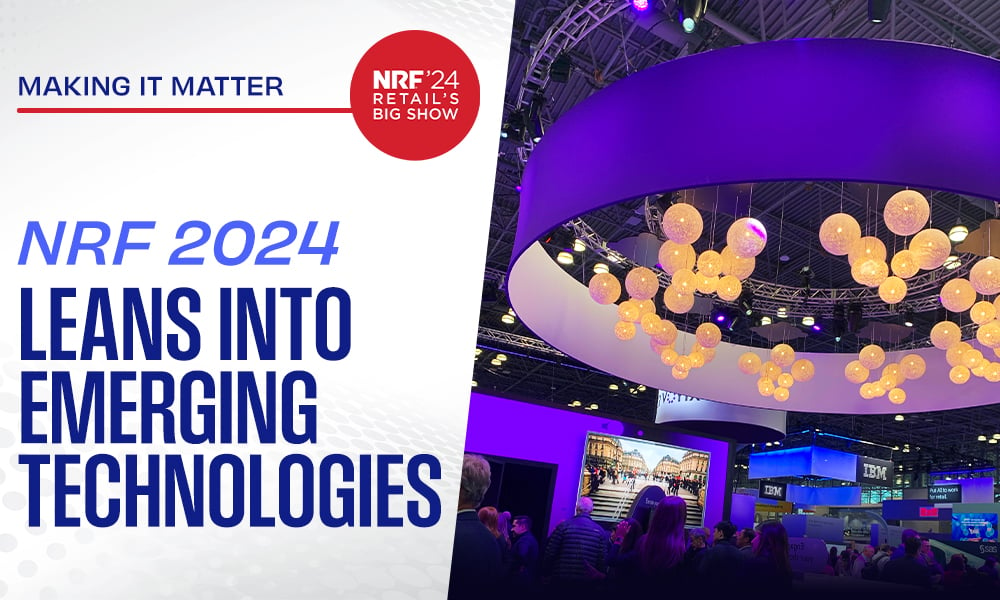
A new year of tradeshows and industry events started with “Retail’s Big Show” in New York City. Several of BlueStar’s executive and business development team attended, meeting with partners, walking the show floor, and tracking the top trends in retail technology. The show featured over 6,000 brands and companies who were exhibiting solutions.
We collected some thoughts and insights from our team and around social media to share our impressions on the tech trends everyone was talking about.
Hot Topics
Artificial Intelligence (AI)
It’s impossible to talk about technology without AI entering the chat...
While AI is nothing new, retailers, solution providers, and the world’s biggest brands heavily emphasize it, from reinventing customer experiences and journeys to analytics, security, loss prevention, returns, inventory management, planogramming, and more.
Retail leaders at the show spoke of a “test and learn” strategy, encouraging others to take risks and explore what AI-driven solutions can do for them. That’s undoubtedly viable for tier 1 retailers, but heard others express caution about AI for the sake of AI without truly examining benefits and expectations.
 "[V]ery few could effectively articulate how AI can truly help a business. Everyone seemed focused on applying AI instead of the outcomes and the transformative tool it can be. Very few explained WIIFM (What's in it for ME, the customer)," Terry Miller, President of V-Kata Group, via LinkedIn, observing how many booths were promoting AI.
"[V]ery few could effectively articulate how AI can truly help a business. Everyone seemed focused on applying AI instead of the outcomes and the transformative tool it can be. Very few explained WIIFM (What's in it for ME, the customer)," Terry Miller, President of V-Kata Group, via LinkedIn, observing how many booths were promoting AI.
 AI is only as good as the data it is receiving, and building user trust and confidence in the data output is critical. Some perceived best practices for ensuring such confidence is conveyed are as follows: rolling out data with a clear baseline, developing good data structure, having an assigned analytics team to test it, training team members on how to utilize the AI engine, and providing the AI engine with feedback so it can learn and grow, improving over time.” - Angela Feeney, Honeywell Business Development and Marketing Manager at BlueStar
AI is only as good as the data it is receiving, and building user trust and confidence in the data output is critical. Some perceived best practices for ensuring such confidence is conveyed are as follows: rolling out data with a clear baseline, developing good data structure, having an assigned analytics team to test it, training team members on how to utilize the AI engine, and providing the AI engine with feedback so it can learn and grow, improving over time.” - Angela Feeney, Honeywell Business Development and Marketing Manager at BlueStar
Those sentiments echo the show’s theme this year: Make it Matter. AI can be a wondrous tool, but we must prove to retailers how and why it will improve their business, directly addressing their challenges.
RFID
RFID has transitioned from “maybe” to “absolutely” for the supply chain. Last year, we surveyed 98 warehouse and logistics leaders, and all but one indicated they use RFID in their business (95% of those daily!). According to researchers, retailers who tag their products with RFID can reach up to 99% inventory accuracy without manual stock counts, essential to stay competitive in the “I want it now” economy.
One panel at NRF, RFID: The Key to Digitizing Loss Prevention, noted that it’s no longer just for “soft goods,” like apparel, but now includes metals, liquid containers, makeup products, and more. “If you sell it, we can tag it” has become a mantra for RFID providers.
These discussions were part of a bigger theme at the show around Supply Chain-as-a-Service (SCaaS), offering opportunities for retailers to use real-time insights into their inventory to manage customer expectations better, connect online to brick-and-mortar, and tackle returns management.
Augmented Reality (AR)
Several big box retailers like Amazon and Wayfair have rolled out their version of Augmented Reality experiences to help shoppers get a better view of how an item will look in their home using 3D vision technology from a mobile app. This digital “try before you buy” strategy includes fashion, home goods, boutique retailers, and more.
CDW’s Jill Klein broke down a list of those top use cases for AR and 3D vision, as well as more intuitive wayfinding and in-store navigation features to help shoppers find products and directions in larger, more daunting store set-ups. We see opportunities for associates using tablets and purpose-built mobile computers to help customers visualize products in a whole new way.
What Else?
Other technology getting attention at NRF included:
- Retail media networks – bringing store and location-specific marketing and entertainment to digital displays.
- Customer-specific targeting – using customer data to create closed-loop marketing, hyper-specific offers, and loyalty programs
- Programmatic advertising - utilizing in-store displays to deliver third-party marketing messages or advertising and creating recurring revenue for retailers
 "There's a great opportunity in the retail space for holograms to allow customers to see life-size products which they can customize in real-time within the display boards." -- Ben Simon, BlueStar's Emerging Technologies Business Development Manager.
"There's a great opportunity in the retail space for holograms to allow customers to see life-size products which they can customize in real-time within the display boards." -- Ben Simon, BlueStar's Emerging Technologies Business Development Manager.
Conclusion
It’s unlikely that topics like AI or AR won’t be discussed at every retail show for the rest of this year and beyond. Still, it’s essential to keep the bottom line in mind: how can we present these solutions in ways that are relevant to retailers' goals? Look for partners that offer emerging technology with meaningful context that can explain the true benefits, outcomes, and potential for business growth. At the SMB retail level, this technology may still feel too far off or expensive to execute, but it should still be a regular part of your conversations with those customers. These innovations, like self-service, modern POS, BOPIS, and more before them, will inevitably make their way down to "mom and pop" retail, so now is the time to position yourself as the leader and expert when the call comes.
As always, if you need help discussing, building, or positioning these solutions, contact us here at BlueStar to find and connect with partners that can elevate your offerings.